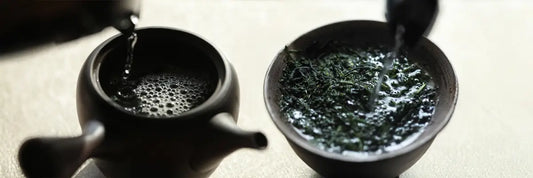Gyokuro vs sencha is an easy comparison to make. The two teas share a lot in common when it comes to their flavor, history and production.
There is also a lot that makes the two different. In this article, we’re going to compare the differences between sencha vs gyokuro and give you all the information you need to know about these incredible Japanese green teas.
Without further ado, let’s get started 🍵🍃
Gyokuro vs Sencha Explanatory Video
If you would prefer learning about the differences between gyokuro tea vs sencha, you can watch our sencha gyokuro video here:
The Basics
So what’s the difference between gyokuro vs sencha? These are two different teas, and before we dive into the caffeine, antioxidants and brewing, let’s briefly define these two iconic Japanese green teas.
 What Is Sencha
What Is Sencha
Sencha is the most common Japanese green tea variety, making up approximately 70% of the total tea produced here.
While sencha is a broad category, it generally refers to tea leaves that have been steamed and rolled to form these tightly rolled needle shapes.
To learn all you need to know about Sencha, we strongly recommend you read the article 👉 Everything You Need to Know About Sencha.

What Is Gyokuro
Gyokuro is considered to be the highest-quality green tea in Japan.
This super flavorful green tea was once reserved for the emperor, but now is enjoyed by tea connoisseurs all across the world.
To understand this special tea, we visited a farmer who has been producing it for decades.
To learn all you need to know about Gyokuro, we strongly recommend you read the article 👉 Everything You Need to Know About Gyokuro Tea.
How It’s Made: Gyokuro vs Sencha
At the heart of the sencha gyokuro difference is how the two teas are made. There are a number of differences between sencha vs gyokuro green tea just in how the two are processed.
Shading
One technique the farmers will use to improve the flavor of a tea is by covering the plants with a type of netting to block out the sun. This stops the leaves from producing catechins, a bitter antioxidant in green tea.
Shaded teas tend to be smoother and sweeter than unshaded teas. Gyokuro by definition has to be shaded for 3 weeks or more before the harvest, while sencha is usually unshaded. In rare instances, sencha can be shaded 7–10 days to reduce the bitterness slightly.
Harvest
The harvesting of gyokuro vs sencha is very similar. Both teas are made using the top 3 leaves of the tea plant. These young sprouts are the richest in nutrients and the sweetest in flavor.
When it comes to first-harvest teas, sencha and gyokuro are really made from the same picking; the only difference so far is that gyokuro needs to be shaded while sencha usually isn’t.
Processing
How the leaves are processed also creates a difference between gyokuro vs sencha. After the leaves are picked, they need to be heated in order to stop the oxidation process and prevent the tea from turning into a black tea.
For both gyokuro and sencha, this heat is applied with steam, but the difference comes down to the length of time. Gyokuro is almost always steamed for 30 seconds (asamushi), but sencha is usually steamed for 45–60 seconds (chumushi). It can also be steamed for longer if the farmer is producing a fukamushi sencha, or deep-steamed tea.
Rolling
If you compare the leaves of gyokuro vs sencha, you’ll notice the gyokuro leaves are much more tightly rolled. This is because gyokuro undergoes an extra rolling phase to create these needle-shaped leaves.
Sencha only undergoes one rolling phase, which curls the leaves into slightly looser needle shapes. These needle shapes allow the leaves to lock in their flavor until they are infused into water.
Gyokuro vs Sencha Health Benefits
There are big differences in the nutrient profile of gyokuro vs sencha. While both these teas are considered very healthy, they are better for different things. In this section, we’re going to compare gyokuro vs sencha caffeine, theanine and gyokuro vs sencha antioxidants to see which tea comes out on top.
Antioxidants
When it comes to the antioxidants in green tea, the primary compound is EGCG or epigallocatechin gallate. These are produced in higher quantities when the tea leaves are unshaded, and they are extracted at a higher temperature. Because sencha tea is shaded for less time compared to gyokuro, it will actually have more catechins. If you really want to get the most antioxidants out of your green tea, you can brew it at a higher temperature, but the flavor will become more bitter.
Theanine
Another difference in gyokuro vs sencha health benefits is theanine. In addition to affecting the caffeine content, the shading process also influences the theanine in the tea. As we mentioned before, when the tea plant is cut off from sunlight, it produces less of these bitter catechins and retains more of its sweet and savory theanine — but what is theanine?
Theanine, or L-theanine in the case of tea, is an amino acid that can induce a calming effect on the brain. This is why you don’t get the same jittery feeling or crash with green tea as you do with coffee. The L-theanine can slow the absorption of caffeine and give you a longer-lasting energy throughout the day.
Caffeine
One factor that makes the gyokuro vs sencha health benefits different is the caffeine content.
Gyokuro caffeine level is somewhere between 120–140 milligrams of caffeine per cup, while sencha caffeine per cup is more or less 40 milligrams.
The reason why gyokuro is so high in caffeine compared to a regular tea like sencha is because of its long shading process.
Gyokuro vs Sencha Taste Differences

The taste difference between sencha vs gyokuro is truly astounding.
While the two teas share a lot in common with regard to taste, there is a lot that separates them.
In this next segment, we will be comparing gyokuro vs sencha taste in terms of aroma, taste, texture, finish, feeling and nutrients.
Aroma
It is difficult to pick up a noticeable difference between the two teas in terms of aroma.
A drier sencha will have more of this citrusy scent to it, while gyokuro will smell sweeter with notes of seaweed.
The real difference will come once you brew up the two teas and compare them.

Taste
In many ways, gyokuro is a more intense version of sencha.
These steamed vegetable flavors are intensified, far more umami is extracted and the finish is more powerful.
There are some aspects of gyokuro that make it entirely unique, however.
This intense brothiness and seaweedy flavor is difficult to detect in a sencha, but it can really dominate the flavor profile of a gyokuro.
Gyokuro taste is something so unique that we even wrote an entire article about it! Make sure to check out our article 👉 What Does Gyokuro Taste Like?
Texture
The texture of gyokuro is much denser than sencha, particularly when it is prepared with a high leaf-to-water ratio.
A fine gyokuro takes on more of an oily consistency you can notice as it glides over the top of the tongue.
The texture of sencha is definitely much thinner and it can have a bit more of a drying sensation on the palate.
Finish
Of course the finish of gyokuro is much stronger and longer-lasting.
What you really notice is the savoriness of this tea that leads to a very satiating finish.
The sencha, on the other hand, tends to have more of a citrusy, mouthwatering finish. Both of these can be enjoyable, but very different.
Feeling
Because gyokuro will have almost double the amount of caffeine compared to sencha, you will notice more of an energy rush from drinking it. The energy boost from gyokuro won’t be quite as rapid or as jittery as it would be with coffee, but it will likely lead to this enhanced alertness throughout the day.
Nutrients
As we mentioned before, gyokuro will have about double the caffeine compared to sencha, but it will also have more theanine as well. Sencha, on the other hand, will have more catechins, which are the antioxidants produced as the plant is exposed to sunlight. If you are looking for a tea to drink during cold and flu season, it can be a good idea to drink a tea like sencha and brew it at a hotter temperature to extract more catechins.
Brewing Methods
There are some differences when it comes to brewing gyokuro vs sencha; you have to respect a certain guideline based on each tea type. Without further ado, let's go through the brewing process for gyokuro and sencha:
Brewing Gyokuro Instructions
When preparing this special green tea, it is important to use a very low temperature, around 60 degrees Celsius (140 degrees Fahrenheit), a smaller amount of water and a longer brewing time of 2 minutes.
This creates a dense, powerful infusion. When enjoying gyokuro, it is common to use an incredibly small cup. When enjoying gyokuro, it is not just about the flavor, but the texture as well.
A good gyokuro is heavy on the palate, and you can really feel the weight of it gliding over your tongue.
This tea is meant to be enjoyed in small sips so you can really savor each and every drop. To learn more about gyokuro brewing methodology, make sure to read our article 👉 Gyokuro Brewing Guide by Tea Experts.
Brewing Sencha Instructions
There is only a slight difference in the preparation of sencha vs gyokuro green tea.
Although it does depend on the type of sencha, in general sencha tea can handle higher temperatures and a shorter brewing time compared to gyokuro.
For fukamushi sencha, you can use a brewing time of 45 seconds and a temperature of 140 degrees Fahrenheit.
For drier sencha teas like the Sencha Isagawa, you can use a temperature of around 160 degrees Fahrenheit and a brewing time of 1 minute.
Which Is Better, Sencha or Gyokuro: A Battle Is Brewing!

So now that we’ve compared gyokuro vs sencha, which one should you choose?
That all depends on what you’re looking for.
Gyokuro is best for an energy boost in the morning, while sencha gives you a calming afternoon cup.
If you like this strong, savory or sweet flavor in Japanese tea, gyokuro will be more to your liking, and if you prefer slightly more acidity and a more steamed-vegetable flavor, sencha can be more to your liking.
If you want to try some of the best gyokuro and sencha teas we’ve found during our travels around Japan, you can browse our selection and choose a few that you’re interested in!





1 comment
Hi there, I enjoy reading through your article. I wanted to write a little comment to support you.